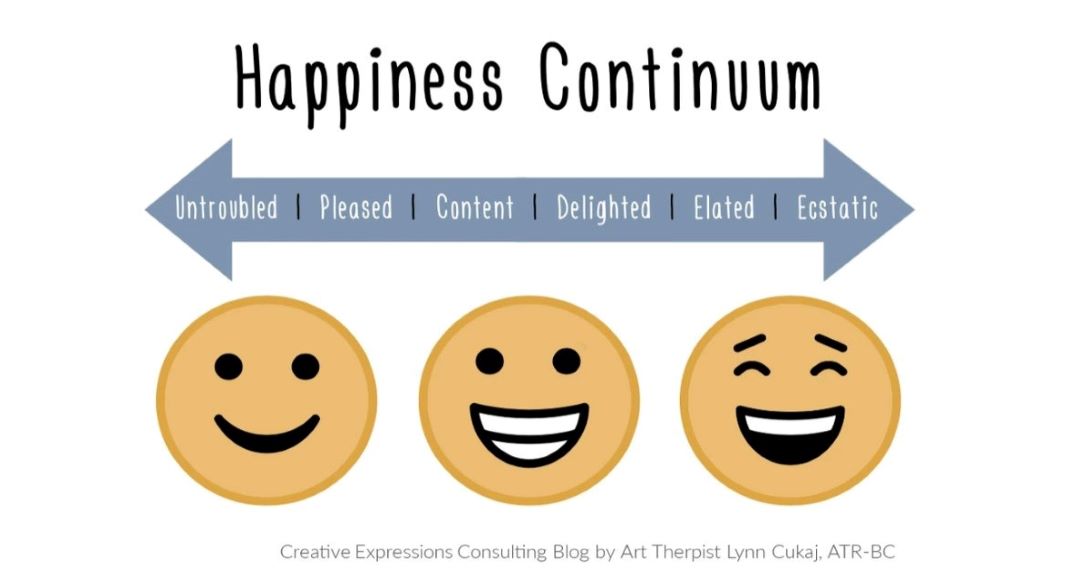 Happiness is a continuum.
Happiness is a continuum.
A continuum that ranges from the feelings of being untroubled or pleased to the feeling of being ecstatic. Expanded, centered, and constricted are existential terms related to becoming more self-aware. Expanded is the highest level, centered is the midpoint, and constricted is the lowest. In terms of the Happiness Continuum, the expansion of happiness would result in feelings of ecstasy and elation. Being centered results in feelings of contentment and delight, and the constriction of happiness is when one feels untroubled.
Interestingly, the words along the continuum are all synonyms for happy, yet they have different meanings.
What comes to mind when you think of an ecstatic or elated person? Are they pleased or untroubled? Delighted? These words are attached to different feelings, yet they are all part of the Happiness Continuum. To me, pleased and untroubled individuals seem to be fine with their lives and are ok with living in the status quo. But if constriction is the lowest part of the Happiness Continuum, it would mean that an individual who is pleased or untroubled may live a passive life without any passions or need for connection.
The status quo may be an OK place to be, but over time, would living the status quo give a person a true sense of happiness in their life and fulfillment of their authentic self? It is not to say that being pleased is less than or wrong; some individuals may thrive with a pleased, untroubled barometer of happiness, which works for them. The key is to determine what works for you.
How do you think a person who feels pleased or untroubled views life versus someone who views life through an ecstatic lens? Is there a difference?
Happiness & Self-Awareness
The belief in obtaining happiness is based on the idea that if we are self-aware, we are happy and have discovered the meaning of life. Is this idea true to you? A practitioner of mindfulness and emotion regulation will experience feelings of contentment, delight, and fullness.
But if we expand on the feeling of happiness, an individual will feel ecstatic and elated. Ecstatic is not manic but rather an individual with high self-awareness. Ecstatic people are good at problem-solving, have good judgment, and move forward in the world with assertion. They are motivated and more willing to take positive risks that may increase their happiness. An ecstatic person will take advantage of work or personal opportunities because they have a growth mindset.
On the other end of the spectrum, a person with a pleased or untroubled perspective may view opportunities as potential situations that will shake up their homeostasis. This could make them unwilling to increase their opportunities to experience more happiness.
The goal is to move along the continuum and not stay on one side, which could hurt your self-awareness over time.
I function better if I push myself beyond my comfort zone to achieve that feeling of elation. For example, the times I motivate myself to cook an elaborate meal rather than the usual standard dish. The feeling of success is ecstatic! This leads me to believe that feeling ecstatic about something has to do with the energy brought to the situation.
To me, happiness is a warm blanket, a cuddle with a puppy or petting a furry cat, the smell of apple pie, or a sunny day. These are concrete things that help me appreciate the abstractness of happiness. Once we define and anchor our happiness, can we sit with that feeling, hold onto it and truly believe that we deserve it? Or is that something only people with intact self-esteem and self-efficacy can experience?
Activity: Does your behavior reflect your values?
Taking a look at the Happiness Continuum, ask yourself the following questions:
- Where do I stand on the Happiness Continuum?
- If I want to achieve the feeling of elation, can change my approach to life and the decisions I make push the bar on the continuum towards feeling happier?
- Am I ok with just feeling pleased?
Once these questions are answered honestly, consider how your behavior and values impact your happiness. Start by asking yourself the following question: What do I value?
Step 1: Using one color pen, rate (not rank) each of the following Personal Values below on a scale of 1-10, 10 being the most important.
If you are having trouble with rating, mindfulness and here & now meditative techniques can help you understand and realistically identify your priorities and values.
Personal Values
- Family (other than marriage and parenting)
- Intimate relationships (partners, marriage)
- Parenting
- Work
- Friends/Social life
- Education/Training
- Recreation/Fun
- Spirituality growth/Mindfulness
- Citizenship/Community life
- Physical self-care
Step 2. Make a list of decisions you had to make in the last week, and then ask yourself the following questions.
- Were you able to make everything you rated a ten a top priority?
- What influenced those decisions?
- How did those choices impact your happiness and your place on the happiness continuum?
It is reasonable to think that outside factors beyond our control impact our choices. However, it is important to reflect on the choices that impact our behavior, resulting in us compromising our values and shifting us down the Happiness Continuum.
Step 3: Using a different color pen, rank each Personal Value based on your decisions and actions from the past week.
Is there a discrepancy? Closing the gap will result in increased self-esteem and happiness as you begin to live a life aligned with your values without compromise.
The key to this activity is to have a balance.
The areas of life you value need to reflect the quality of life and the level of happiness you are working toward. For example, if you highly value your family (other than marriage and parenting), do your consistent actions reflect its importance?
To maintain certain personal values at a 10, you may need to prioritize other values that are not high on your list. For example, if you are looking to prioritize your mindfulness and spiritual growth, you may need to make meditation more of a priority in your daily activities. If physical or self-care are rated low, think of activities you can do during the day that will allow you to take better care of your body.
If you approach life in a meaningful way that speaks to your values, the resulting behaviors will fall into place. It is important to note that what you value and how you place it in the importance rating will significantly depend on your life stage. Our values change over time, and this is an exercise that can be practiced often to gain insight into our journey through life.
How do you want to live your life?
Learn more about Art Therapy and Lynn Cukaj, Board Certified Art Therapist, at www.CreativeExpressionsConsulting.com
Lynn Cukaj is an art therapist, educator, and counselor. She works with children to help them gain insight into their strengths. Those strengths are then supported to help with the presenting problem, friendship issues, identification and regulation of feelings, communication skills, etc. This process is done by using art or talking, whichever is more comfortable for the child.




















